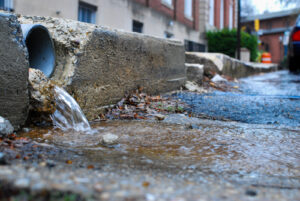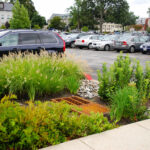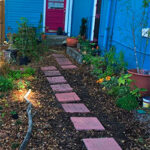An estimated 10 trillion gallons of untreated stormwater runoff, containing everything from raw sewage to trash to toxins, enters U.S. waterways from city sewer systems every year, polluting the environment and our drinking water supplies. The EPA describes stormwater runoff as one of the fastest growing sources of pollution in the US.
Streets, parking lots, rooftops and other non absorbent surfaces repel stormwater, preventing it from soaking into the land, and forcing it to flow as runoff. The average city block can generate more than five times as much runoff as a forested area of equal size.
Our Sewage Systems Contribute to the Problem

(Photo credit: Matt Rath/Chesapeake Bay Program)
Many urban areas have combined sewage systems (CSS), which are designed to collect rainwater runoff, domestic sewage, and industrial wastewater into one pipe. Under normal conditions, CSSs transport all their wastewater to a water treatment plant, where it is treated before being discharged into a body of water.
During periods of heavy rainfall, however, wastewater volume in a CSS can exceed the capacity of the sewer system. To solve this, CSSs are designed to overflow occasionally and discharge excess wastewater directly to nearby streams, rivers, or other water bodies. This practice is called combined sewage overflow (CSO), and the “overflow” contains not only stormwater but also untreated human and industrial waste, toxic materials, and debris.
CSOs are a major concern for public health as they negatively impact water quality, threatening the water we drink, the seafood we eat and our recreational areas. They introduce disease-causing bacteria into bodies of water that treatment facilities can’t always filter out.
Vulnerable Communities Are Disproportionately Affected by Aging Infrastructure
Vulnerable communities, which tend to house lower income and minority populations, are more likely to be affected by health problems as a result of stormwater-induced flooding.

(Photo Credit: Flickr)
New Orleans, which, according the most recent census data has the highest poverty rate among the country’s 50 largest urban areas, is also a prime example of a city with extreme water challenges due to rainfall events, subsidence and aging infrastructure.
The city is below sea level and shaped like a bowl, which means that, when it rains, it holds the water. Because there’s so much concrete, the stormwater cannot be absorbed into the ground, and it overwhelms the city’s drainage system and has to be regularly pumped out.
And climate change is only going to make this situation worse. Heavy rain events have increased in frequency and intensity in the past 50 years, and they’re expected to increase dramatically across the United States as global temperatures continue to rise.
This will put still more pressure on already overworked infrastructure systems.
Green Infrastructure as a Solution

Green infrastructure is an alternative to traditional water management systems that offers cost-effective solutions to flooding and stormwater pollution. Green water management practices like vegetated rooftops, roadside plantings, and absorbent gardens increase the quality and quantity of local water supplies and provide other environmental, economic, and health benefits to urban areas.
Green infrastructure prevents runoff where it falls, allowing it to filter into the environment, where it can replenish groundwater supplies or be reused for another purpose, like landscaping or irrigation. It improves water quality by decreasing the amount of stormwater that reaches waterways and removing contaminants.
Soil and plants help capture and remove pollutants through absorption, filtration, plant uptake and decomposition. The more permeable (or absorbent) a surface is, the less runoff there will be. Porous natural landscapes, such as meadows and forests, can soak up as much as 90% of the rain they receive.

Vulnerable Communities Leading the Way With Green Infrastructure
Many green infrastructure solutions are viable in vulnerable communities because they have relatively low cost and are easily implementable. In New Orleans, community-led initiatives have evolved to help the city and its residents mitigate flooding:
- Every Drop Nola supports public projects for water mitigation across the city through joint partnerships between the Sewage and Water Board, residents, businesses and local non-profit organizations.
- I See Change New Orleans collects community records of climate and weather, which are presented to the scientists, engineers, planners, journalists, and civic groups who are actively planning a more resilient future.
- Healthy Community Services is a nonprofit organization that works in collaboration with Water Wise Gulf South to educate the community on urban stormwater management techniques, how the drainage system of New Orleans works, improving the water quality and how green infrastructure reduces subsidence by increasing the water table levels.
What Can You Do?

Local non-profits and governmental organizations are working towards green infrastructure solutions in many communities, including your own!
Consider implementing one of these household-level green infrastructure options to make a difference in your community:
♥ Install a rain barrel
♥ Plant a rain garden
♥ Plant a tree
♥ Keep catch basins clean and clear
♥ Remove excess concrete
